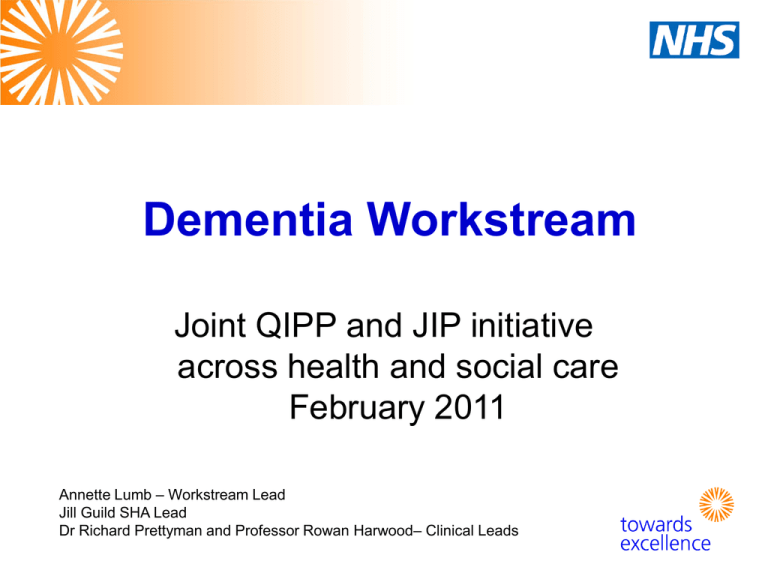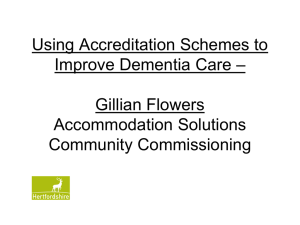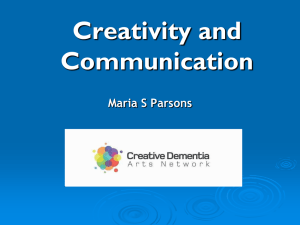Delivering the benefits of Dementia QIPP and JIP
advertisement

Dementia Workstream Joint QIPP and JIP initiative across health and social care February 2011 Annette Lumb – Workstream Lead Jill Guild SHA Lead Dr Richard Prettyman and Professor Rowan Harwood– Clinical Leads Case for change • East Midlands alongside the South West faces the most significant challenge in England. In 2010 there were 52,836 people living with dementia in the East Midlands rising to 82,155 in 2025 (55% increase). Direct costs to the NHS and social care will treble as a result by 2030. • Diagnosis is a gateway to appropriate care: Only 37% of people with dementia are currently diagnosed in the East Midlands and services for dementia are acknowledged to be underdeveloped in all sectors (community, specialist MH, care homes, and acute hospitals). • As a result too few people access appropriate prevention, early intervention and intermediate care and too many people with dementia are admitted to high cost services in hospitals and residential care (up to 1/3 of people in acute beds and 2/3 of people living in care homes have dementia). • Investing in diagnosis, early intervention and improving quality of dementia care should release savings through reduced admissions to hospitals and care homes (e.g. £6 million per District General Hospital (DH 2011), 1 year delay in admission to a care home). Savings realised will need to be reinvested to deliver quality services in line with rising need. Variation & Opportunity Proportion of Dementia Coding in >65 Emergency Admissions (Q1 1011) -0.85% 0.10% -0.93% -0.40% -1.60% 0.25% -0.28% LEGEND 99.8% Confidence Interval 20% 18% 16% 3SD CONTROL LIM ITS 14% 12% 10% 8% MEAN 6% 4% Q1 1011 Q4 0910 Q3 0910 Q2 0910 VALUE UHL Q1 0910 ULHT Q4 0809 SFHFT Q3 0809 NUH Q2 0809 NGH Q1 0809 KGHFT Q4 0708 DHFT Q3 0708 0% CRHFT Q2 0708 2% Q1 0708 20% 18% 16% 14% 12% 10% 8% 6% 4% 2% 0% -0.54% Regional mean Provider CRHFT FY 0708 FY 0809 Q1 0910 Q2 0910 Q3 0910 Q4 0910 FY 0910 Q1 1011 10.37% 11.02% 11.08% 12.00% 11.75% 12.06% 11.73% 11.52% DHFT 9.55% KGHFT 10.28% 10.21% 11.12% 11.33% 11.34% 12.37% 11.56% 12.47% NGH 10.51% 10.93% 11.38% 11.01% 12.20% 12.52% 11.80% 11.59% NUH 9.36% SFHFT 12.28% 12.73% 13.60% 15.37% 15.75% 15.05% 14.94% 13.45% ULHT 9.50% 9.42% 9.60% 10.45% 11.13% 12.25% 10.84% 12.50% UHL 8.87% 9.66% 9.69% 9.44% East Midlands 9.85% 10.04% 10.16% 10.49% 10.91% 12.10% 10.93% 11.66% National 7.15% 10.68% 7.94% 9.30% 6.62% 10.08% 7.98% 9.55% 9.96% 8.20% 9.11% 11.92% 10.23% 11.52% 10.31% 11.73% 10.31% 11.45% 11.65% 11.80% 12.48% 12.99% 12.24% 12.94% Narrative: There is variation in the coding of dementia in emergency admissions for the >65 across the region. The regional average is slightly below that seen nationally but has been improving in the last 3 years from 9.85% to 11.66%. Three trusts in the region are coding patients above the national average whilst DHFT are the only trust significantly below national and their peer group. The low percentages could be because the coding of dementia is not relevant to the admission. However early diagnosis in an acute setting will have an impact on the care and experience a patient receives. Variation & Opportunity LoS for the Top 3 Dementia Coded Primary Diagnosis (UTI, Pneumonia and #NOF) in >65 emergency admissions (FY 0910) LEGEND 99.8% Confidence Interval 21 Avg LOS 18 3SD CONTROL LIM ITS 15 12 9 6 MEAN 3 4 Days Increase when a patient is coded with dementia 24 0 3 2.5 2 1.5 1 0.5 0 CRHFT HES 3.5 DHFT KGH NGH NUH National mean without dementia coding Provider CRHFT DHFT KGHFT NGH NUH SFHFT ULHT UHL East Midlands National SFHFT ULHT UHL National mean with dementia coding No. of patients Total number of Avg LoS without Avg LoS with with a dementia patients dementia coding dementia coding coding 1495 2443 1489 1101 3299 1753 2982 3765 18327 228312 408 576 356 303 1007 504 723 880 4757 59644 16.05 14.68 16.34 21.61 12.62 11.68 15.51 13.20 15.21 15.71 19.38 17.67 19.26 23.16 13.98 13.56 18.15 15.57 17.59 18.03 CRHFT VALUE HES DHFT KGH NGH NUH SFHFT ULHT UHL National Days Increase Narrative: When comparing LoS for patients with and without dementia coding when they are admitted for UTI’s, Pneumonia and #NOF most trusts arte operating around the national averages. NGH have a significantly longer Los in both scenarios which may require further investigation. NUH have a 1.36 day difference between the two cohorts of patients which could indicate good practice that could be shared across the region Variation & Opportunity 60% LEGEND 3.59% 2.96% -0.97% 3.64% 0.41% 2.78% 1.45% 2.31% 2.31% 3SD CONTROL LIMITS 50% PEER MIN - MAX 40% MEAN 1 30% VALUE 20% 99.8% C.I. % of dementia patients on a GP QOF register who have had their care reviewed in the last 15 months % of expected dementia population diagnosed in the GP QOF dementia register QOF Indicators (2009/10) 100% -5.28% -0.46% -0.33% -0.26% 0.71% 3.57% 2.49% 0.83% -0.43% 90% 80% 70% 60% TREND Q4 vs Q3 Regional mean National mean Narrative: All trusts within the region, with the exception of Derbyshire County, have seen an improvement in the diagnosis of dementia over expected prevalence in the last year. However with this in mind there is still wide variation between the trusts, 15.41% between the highest and lowest in the region. Looking at the peer analysis nearly all trusts are within their peer ranges, Lincolnshire are above their maximum peer range whilst LCR are below their minimum peer range. There is less variation between the trusts in the care review measure . Bassetlaw have seen more of their dementia patients for a care review in the last year even with the largest decrease from the previous year. Derby City are below their peer minimum peer range for care reviews of their dementia patients. Variation & Opportunity Programme Budgeting Spend per head of population on OMHD (£) 35 30 25 20 15 10 5 0 2008-09 2009-10 Dementia services spend per head of population 2009-10 30 25 20 15 10 5 - Narrative: Commissioner level programme budgeting data is published annually to enable commissioners to identify : • spend over the 23 disease groups and their respective subcategories; • how, and by how much, their expenditure distribution pattern compares with other commissioners nationally, locally or with similar characteristics and; • how their expenditure distribution has changed over time. Dementia is included within the subcategory of Organic Mental Health Disorders (OMHD) which is part of the Mental Health Disorders category. In addition, for 2009/10 NHSEM asked PCTs to provide data on spend specifically on dementia services. In the Organic Mental Health Disorders category, PCT spend per head of population increased for the majority of PCTs from 2008/09 to 2009/10. For expenditure on OMHD and dementia Northants is significantly below the rest of the East Midlands. Variation & Opportunity Social Care Data – Recording of Dementia % of predicted prevalence CSSR clients 65+ with dementia as a proportion of predicted dementia prevalence (2009/10) 30% 20% 10% 0% % predicted East Midlands Total number of Predicted % of CSSR clients number of predicted in CSSR recorded people with contact with dementia in with CSSR dementia area (65+) (65+) 9.2% Derby City 260 2,830 9.9% Derbys 975 9,800 29.0% Leic City 755 2,605 4.9% Leics 390 7,880 1.2% Lincs 120 10,105 8.1% Northants 585 7,230 24.3% Nott City 620 2,555 22.4% Notts 2,180 9,750 6.4% Rutland 35 545 5,925 53,300 12.8% East Midlands Narrative: In 2009/10 a total of 5,925 clients aged 65+ years with dementia received services provided or commissioned by Councils with Social Services Responsibilities (CSSRs) in the East Midlands - representing 12.8% of the estimated number of people with dementia in the region. While not all people aged 65+ with dementia will need or want a CSSR service, the provision of such services to only 1 in 8 of the estimated dementia population appears low. There is significant variation in the proportion of people with dementia who are recorded as receiving a service by area – from 1.2% in Lincolnshire to 29.0% in Leicester City. However, this does not necessarily imply that people with dementia in Lincolnshire are less likely to receive a CSSR service. The apparently low number of people with dementia receiving a service could be due to failure to recognise and/or record the diagnosis correctly. There is no significant correlation between the % of expected dementia prevalence recorded with dementia on receiving a CSSR service, and the % of the expected dementia population recorded on GP QOF dementia registers. Two of the areas where a higher % of the estimated number of people with dementia received a CSSR service (Leicester City and Nottingham City) also had high QOF register completion rates. However, other areas show no relationship e.g. Lincs has very low CSSR diagnosis rates but average QOF registration rates, and Notts has high CSSR rates but average QOF rates. Source of data: RAP (Referrals, assessments and packages of care) 2009/10 data available via www.nascis.ic.nhs.uk Variation & Opportunity Social Care Data – Service Type Provided CSSR clients 65+ with dementia - service type provided (2009/10) 80% 70% 60% 50% 40% 30% 20% 10% 0% CSSR Community based services Residential Care Nursing Care Derby City Derbys Leic City Leics Lincs Northants Nott City Notts Rutland East Midlands % receiving % receiving % receiving communityresidential nursing based care care services 65% 63% 58% 45% 75% 55% 69% 47% 71% 55% 25% 29% 42% 55% 33% 54% 31% 39% 43% 39% 27% 10% 12% 14% 8% 14% 13% 14% 0% 13% Narrative: Across the East |Midlands, 55% of CSSR clients recorded with a diagnosis of dementia received a community-based service, 39% received residential care and 13% received nursing care (does not total 100% as some clients received more than one service type). There is significant variation in the patterns of care provided across the region. A high % of clients in Leicestershire and Northants received residential and/or nursing care, whereas in Lincolnshire a high % received community-based services. In most areas the % receiving residential care was higher than the % receiving nursing care, the exception being Derby City where 27% of dementia clients received nursing care compared to only 25% who received residential care. However, this analysis is subject to the issues described previously regarding completeness of dementia diagnosis recognition and recording. Analysis of cost data has been undertaken (using PSSEX data), but this was not robust due to variation in practice in apportioning costs between service types and also inability to identify costs specifically for the dementia cohort (PSSEX data are only available for the 65+) age group and are not diagnosisspecific). Source of data: RAP (Referrals, assessments and packages of care) 2009/10 data available via www.nascis.ic.nhs.uk Products achieved The NHS East Midlands QIP/JIP workstream has: Product Status 1. EMPHO East Midlands Dementia Profile, Mapping and analysis of current services, PDF in all localities (excludes Derbyshire) and action plans complete 2. Systems Dynamic modelling tool to support commissioning of dementia services (can be accessed by other regions also) complete 3. Case study service specifications for memory services 4. Funded commissioning support across health and social care (Local Dementia Programme Leads) 5. Case study basic dementia training in care homes (all local authorities participating in project) 6. Integrated workforce plans for dementia (excludes Lincolnshire) 7. Acute hospital dementia coding guidance In progress Complete, report in progress In progress In progress In progress 8. Acute hospital resource pack In progress 9. Accessible standards – Dementia charter In progress 10. Updated prescribing guidelines for use of anti psychotics, audit methodology, and behavioural management guidelines In progress 11. Social Care Metrics grid In progress 12 Telecare dementia pilots In progress 13. East Midlands compendium of good practice complete Attachment Case study / good examples Derbyshire County Council (working with NHS Derbyshire) opened the first of 8 planned community care centres in Staveley in 2010. The centre provides services to people with dementia. The centre aims to provide good quality person centred support and integrated community services that prevents individuals (or their carers) reaching crisis, needing hospital admission or anti psychotic medication. The centre offers residential beds, intermediate care beds, open access community facilities, and day opportunities. The centre is used by social care, health and the voluntary sector and the local community. The sited is adjacent to a school thus providing opportunity for intergenerational work. A new memory assessment service provided by the mental health trust operates from the centre. The local authority will be evaluating outcomes of implementing the new model of care. GPs in Gnosal Staffordshire have led the redesign of memory assessment services based on a pilot in primary care. For a list size of 7199 in 2006 ( predicted prevalence dementia 60) rising to 8000 in 2009 savings identified against mental health and acute hospital admissions of £400,000 per year. Diagnosis rates have increased from 6 in 2006 to 38 in 2009 and it is expected that 80% of people will receive a diagnosis by 2013/14. Time from initial contact to diagnosis was 3 years in 2006 and was reduced to 4 weeks and in 2009. Only 2 people diagnosed with dementia were admitted to a hospital or care home in 2009. As a result of the pilot new care pathways and service specifications have been designed and the service has been re-tendered. The successful provider supporting GPs to deliver the new model is MAC UK Neurosciences. Healthcare for London has produced a Dementia Services Guide that includes integrated care pathways, general hospital care pathways, and commissioning specifications for memory services. www.healthcareforlondon.nhs.uk/assets/Mental-health/HealthcareforLondon_Dementia-servicesguide.pdf Securing the benefits Securing the benefits Provider Implement and optimal care pathway in line with NICE guidance for dementia that •maximises opportunity to increase capacity •Includes suite of evidenced based diagnostic tools •Includes evidence based protocols •Includes follow-up using the most cost effective system for 6 month review System in primary care to link QOF recording and diagnosis in provider organisations Commissioner Agree current activity and cost baseline for memory services and secure PBR clustering in order to differentiate dementia patients Develop outcome focused service specifications Memory Assessment Redesign Develop a strategy to increase capacity in line with increasing prevalence rates e.g. through re-tender Agree system to ensure diagnosis is translated to QOF register Understand acute sector costs and activity for dementia, % dementia patients versus non Appoint a lead clinician, implement a dementia care dementia, Los and relevant costs with and pathway and protocols, compliance with NICE and without complications. Benchmark between RCP standards, analyse data on LoS and dementia providers Improved quality in Acute care versus non dementia patients. Compliance with Quality indicators: Optimal LoS, NICE Standards, RCP Organisation of Use coding guidance for dementia to improve Services Standards standardisation of coding Ensure access to liaison and intermediate care/ reablement Prescribers comply with prescribing guidelines Audit (use of low dose anti psychotics) Implement guidelines for managing challenging Adopt prescribing guidelines Reduction in anti psychotics prescribed to Plan to reinvest savings into training and behaviour people with dementia Mental health trust were contracted provide inpsychological interventions to manage reach into care homes challenging behaviour Local authority commissioners specify quality Identify dementia champion, implement a rolling standards for dementia in line with NICE training plan, Implement person centred planning Improved quality dementia care in care home standards (awareness training, person centred including life story work Implement guidelines for planning, management of challenging managing challenging behaviour behaviour. leadership) Main Regional Contact Regional Workstream Executive Sponsors Mike Shewan, Chief Executive Derbyshire Mental Health Services NHS Trust mike.shewan@derbysmhservices.nhs.uk David Pearson, Director of Adult Social Care and Health Nottinghamshire County Council David.pearson@nottscc.gov.uk Clinical Leads Professor Rowan Harwood, Consultant Geriatrician University Hospitals Nottingham Rowan.Harwood@nuh.nhs.uk Dr Richard Prettyman, Consultant Psychiatrist, Leicestershire Partnership NHS Trust richard.prettyman@leicspart.nhs.uk Workstream Lead Annette Lumb, Strategic Relationship and Programme Manager Department of Health Annette.lumb@dh.gsi.gov.uk SHA Lead Jill Guild Strategic Relationship and Programme Manager Jill.guild@nhs.net Nottinghamshire Local Dementia Programme Lead – Vicky Wright Victoria.Wright@nottspct.nhs.uk NHS Nottinghamshire and Bassetlaw – Gill Oliver gill.oliver@nottspct.nhs.uk NHS Bassetlaw – Vicky Wright Victoria.Wright@nottspct.nhs.uk Nottinghamshire County Council – Jane Cashmore jane.cashmore@nottscc.gov.uk NHS Nottingham City – Joanne Williams joanne.williams@nottinghamcity.nhs.uk Nottingham City Council – Rod Madocks rod.madocks@nottinghamcity.gov.uk Derbyshire Local Dementia Programme Lead – Ciara Scarf Ciara.Scarff@Derbyshire.gov.uk NHS Derbyshire - Jane Yeomans Jane.Yeomans@derbyshirecountypct.nhs.uk Derbyshire County Council - Julie Vollor Julie.Vollor@Derbyshire.gov.uk NHS Derby City – Ciara Scarf Ciara.Scarff@Derbyshire.gov.uk Derby City Council – Phil Holmes phil.holmes@derby.gov.uk Lincolnshire Local Dementia Programme Lead – Deborah Shepherd NHS Lincolnshire - Colin Warren colin.warren@lpct.nhs.uk Lincolnshire County Council – Deborah Shepherd Deborah.shepherd@lincolnshire.gov.uk Leicestershire Local Dementia Programme Lead – Sharon Aitkin Sharon.Aiken@leics.gov.uk NHS Leicestershire and Rutland – Vanessa Griffiths and Jane Thorpe vanessa.griffiths@lcr.nhs.uk jane.thorpe@lcrchs.nhs.uk Leicestershire County Council – Katie Anderson Katie.Anderson@leics.gov.uk Rutland County Council –Sharon Aitkin Sharon.Aiken@leics.gov.uk NHS Leicester City – Liz Eastwood liz.eastwood@leicestercity.nhs.uk Leicester City Council – Bindu Parmar Bindu.Parmar@leicester.gov.uk Northamptonshire Local Dementia Programme Lead – Jonathan Ward Langman and Gerry McMurdie jwardlangman@northamptonshire.gov.uk GMcMurdie@northamptonshire.gov.uk NHS Northamptonshire – Catherine O’Rourke Catherine.O'Rourke@northants.nhs.uk Northamptonshire County Council – Jonathan Ward Langman jwardlangman@northamptonshire.gov.uk Challenges • • • • • • • • • The need for health and social care organisations to save money Work stream focuses on improving quality & outcomes Initial costs required to maximise benefits (invest now, save in future) Need to implement all recommendations to maximise potential Benefits are not instant –takes time Costs and benefits do not fall equally across health and social care Obtaining credible data for measurable quality benefits and metrics, and to show variance Exposure to those with influence that have competing other priorities The rapidly increasing demand over coming years with anticipated doubling in need by 2030 Summary & questions To summarise: • Early diagnosis and intervention reduces use of expensive hospital and care home services. Agree baseline with Mental Health Trusts to scope capacity to redesign Community Mental Health Teams and identify capacity to deliver new service specification for memory services and early intervention as part of SLA. Include dementia in reablement plans. • Improved quality of care in nursing and care homes can help to reduce use of anti-psychotics and reduce admissions to hospital Agreeing model to support nursing and care homes to improve dementia awareness and to manage challenging behaviour. E.g. access to NHS training monies/ modules and in-reach support from Community Mental Health Teams • Implementation of acute hospital trust Royal College of Psychiatrists guidance, will reduce Length of Stay Ensure acute trusts implement coding guidance and RCP quality standards and work with acute trusts to develop liaison services • Reduce use of anti psychotics by2/3 Audit use of low dose of anti psychotics and implement prescribing guidelines alongside improving access to specialist in-reach and training in the management of challenging behaviour in nursing and care homes









